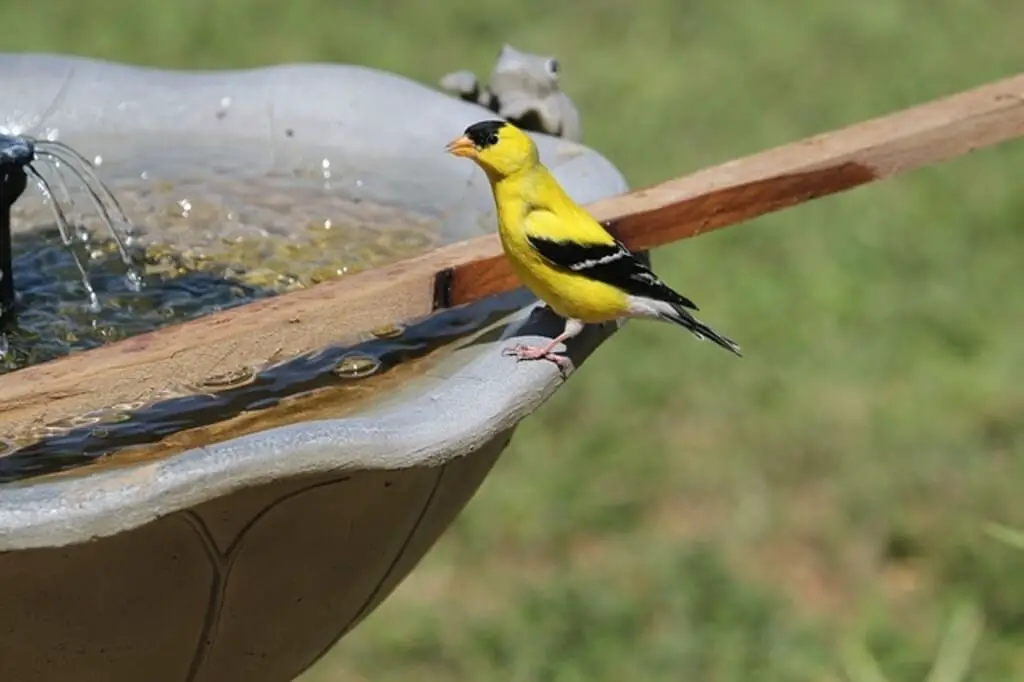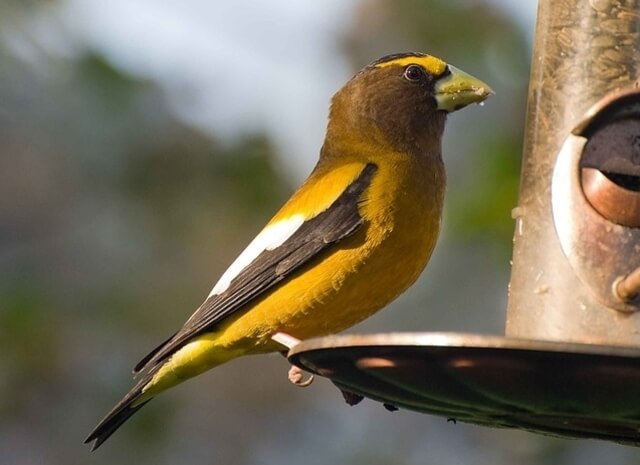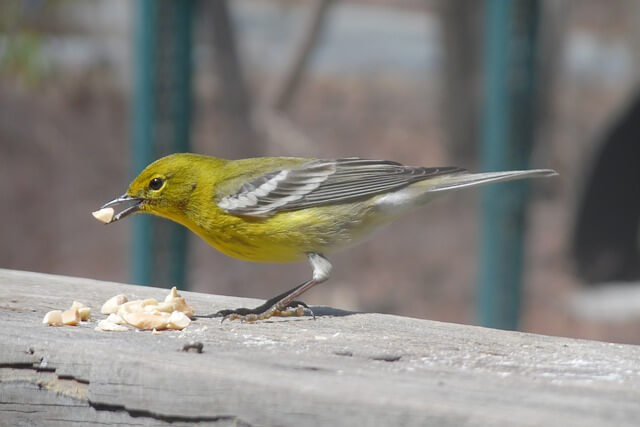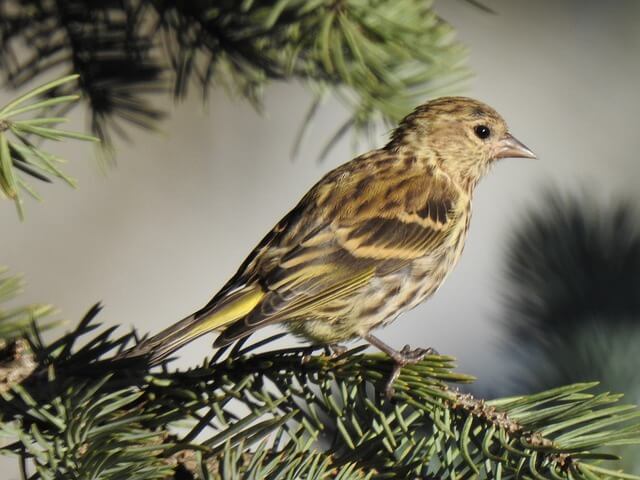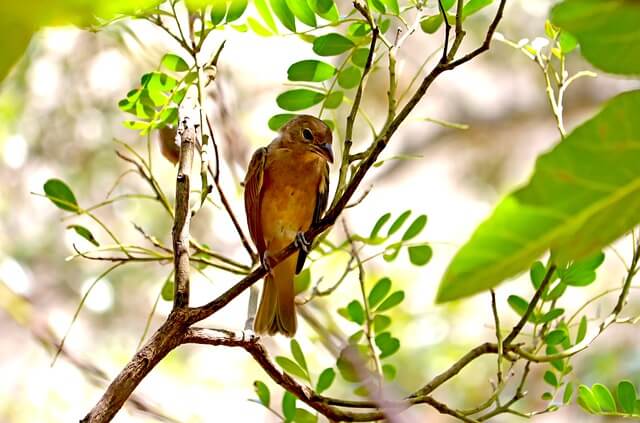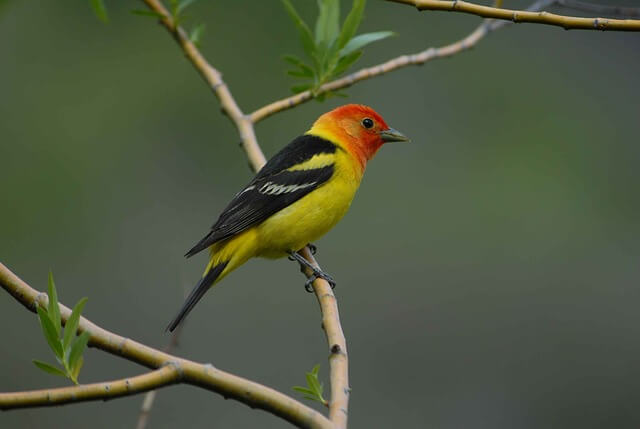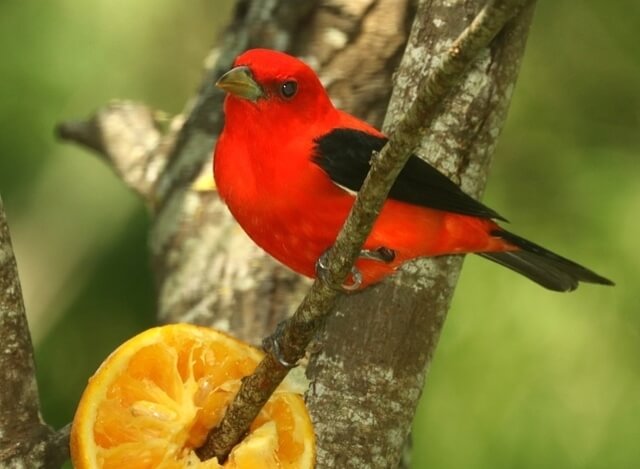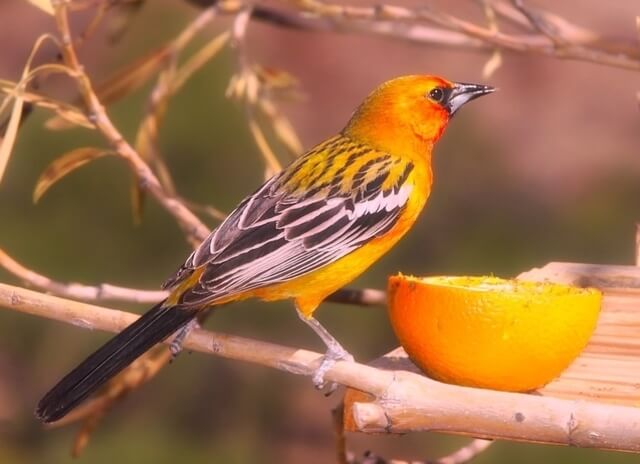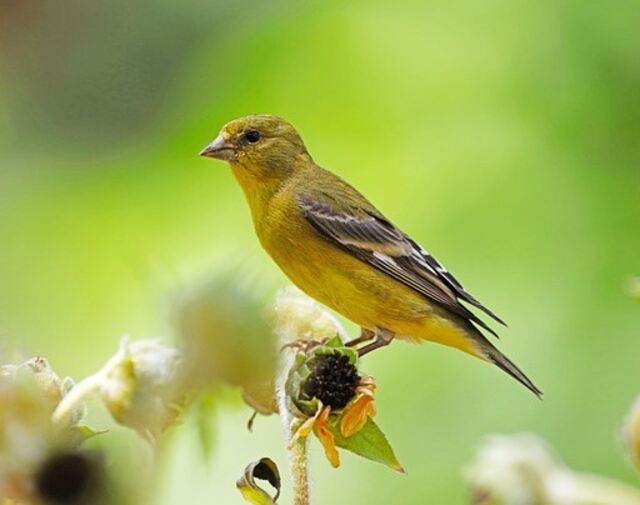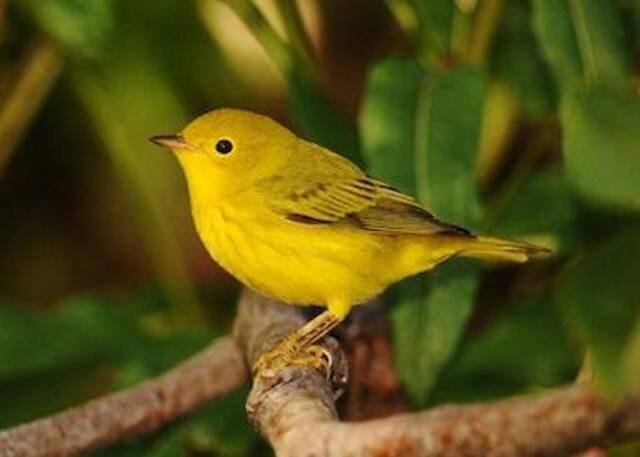Goldfinches are beautiful birds that many people enjoy watching. They’re also one of the more popular birds in America, with an estimated population of over 7 million.
This makes them a common sight to see on any bird feeder, and it’s easy to mistake other types of small birds for goldfinches when they fly by.
In this article we provide a list of 9 similar looking birds as well as go through the variances between them, so you can tell which is which!
Table of Contents
American Goldfinch
The American Goldfinch, a native North American finch species, can be spotted in suburban settings like parks and gardens. Interestingly, it has found its way to other corners of the globe, including Australia, Europe, Asia, Africa, and New Zealand.
Within North America, these delightful birds predominantly inhabit the United States and southern Canada, extending their breeding range as far south as Mexico and even Costa Rica in Central America. In appearance, males exhibit vibrant black caps and striking yellow bodies, while females boast brown crowns and lighter plumage along their backs.
Their dietary preferences lean toward seeds, sourced from a variety of plants such as thistles, sunflower heads, goldenrod, and dandelions. However, they occasionally supplement their diet with insects. When it comes to building their nests, American Goldfinches utilize materials like grasses, weed stems, feathers, and plant down.
Birds That Look Like Goldfinches
Evening Grosbeak
| Bird | Length (in) | Weight (oz) | Wingspan (in) |
|---|---|---|---|
| Evening Grosbeak | 7.5 – 8.3 | 1.4 – 1.9 | 12.6 – 14.2 |
The Evening Grosbeak is a large, colorful finch that is native to North America. These birds are known for their striking yellow, black, and white plumage, as well as their large, conical bills, which they use to crack open seeds and nuts.
Evening Grosbeaks are social birds and often travel in flocks, which can number in the hundreds. They are non-migratory and can be found in a variety of habitats, including coniferous forests, deciduous forests, and suburban areas.
Evening Grosbeaks are known for their distinctive, sweet calls, which are often described as sounding like “cheer, cheer, cheer.” Despite their striking appearance, Evening Grosbeaks are considered to be a threatened species due to habitat loss and other factors. Conservation efforts are underway to protect these beautiful birds and ensure their survival for future generations to enjoy.
Attracting Evening Grosbeaks to Your Yard:
Evening Grosbeaks are striking birds with vibrant plumage. To attract them, focus on providing the right food and shelter. Fill your feeders with sunflower seeds and cracked corn. Plant a variety of evergreen and deciduous trees to create a woodland habitat. Installing a birdbath or pond will give them a place to drink and bathe.
Pine Warbler
| Bird | Length (in) | Weight (oz) | Wingspan (in) |
|---|---|---|---|
| Pine Warbler | 4.7 – 5.1 | 0.3 – 0.4 | 7.5 – 9.1 |
The Pine Warbler is a small, yellowish-green bird that is native to the eastern United States. These birds are known for their distinctive, musical trill, which can often be heard in pine forests during the spring and summer months. Pine Warblers are primarily insectivores and feed on a variety of insects, including caterpillars, beetles, and ants.
They also consume seeds and berries during the winter months when insects are scarce. Pine Warblers are monogamous and typically mate for life. They build their nests in pine trees, using twigs, grasses, and other materials to create a cup-shaped structure.
Despite their name, Pine Warblers are not exclusively found in pine forests and can also be found in mixed woodlands and suburban areas. These birds are a common sight for birdwatchers and nature enthusiasts, and their distinctive calls and bright plumage make them a popular species to observe in the wild.
Enticing Pine Warblers to Your Garden:
Pine Warblers love insects, suet, and mealworms. Set up suet feeders and offer mealworms to tempt them. Create a habitat with a mix of pine trees and open spaces for foraging. Hang nest boxes in the pines to encourage breeding.
Pine Siskin
| Bird | Length (in) | Weight (oz) | Wingspan (in) |
|---|---|---|---|
| Pine Siskin | 4.3 – 5.1 | 0.4 – 0.5 | 7.5 – 9.8 |
The Pine Siskin is a small, finch-like bird that is found throughout North America. These birds are known for their brownish-yellow plumage with black streaks and their sharp, pointed bills, which they use to extract seeds from cones and other sources. Pine Siskins are highly nomadic and their movements are often tied to food availability.
During the winter months, they may form large flocks and move southward in search of food. Pine Siskins are also known for their unique vocalizations, which include a variety of chirps, trills, and buzzes. They are often found in coniferous forests, but can also be seen in suburban areas and backyards, especially during times of food scarcity.
Despite their small size, Pine Siskins are hardy birds and are capable of surviving in cold, harsh environments. They are a popular species among birdwatchers and are known for their acrobatic feeding behaviors and their ability to survive in challenging conditions.
Attracting Pine Siskins to Your Feeder:
Pine Siskins enjoy nyjer seeds and sunflower seeds. Use mesh feeders for nyjer seeds and keep them well-stocked. Plant conifers and evergreen trees in your garden. Offer fresh water in shallow dishes or a birdbath for drinking and bathing.
Summer Tanager
| Bird | Length (in) | Weight (oz) | Wingspan (in) |
|---|---|---|---|
| Summer Tanager | 6.3 – 7.1 | 0.6 – 0.8 | 10.6 – 11.8 |
The Summer Tanager is a brightly colored bird that is found in parts of North and South America. These birds are known for their striking red plumage, which is more vibrant in males than in females. Summer Tanagers are primarily insectivores and feed on a variety of insects, including bees, wasps, and beetles. They are also known to consume fruits and berries during the winter months when insects are scarce.
Summer Tanagers are monogamous and typically mate for life. They build their nests in trees and shrubs, using twigs, grasses, and other materials to create a cup-shaped structure. Summer Tanagers are known for their distinctive, robin-like calls, which can often be heard in wooded areas during the breeding season.
Despite their name, Summer Tanagers are not exclusively found in the summer months and can be seen year-round in parts of their range. These birds are a popular species for birdwatchers and nature enthusiasts, and their bright plumage and unique vocalizations make them a favorite among many.
Creating a Haven for Summer Tanagers:
Summer Tanagers have diverse tastes, including insects, fruit, and nectar. Set up fruit feeders and plant nectar-rich flowers like trumpet vine. Ensure your garden has dense, shrubby areas for nesting.
Western Tanager
| Bird | Length (in) | Weight (oz) | Wingspan (in) |
|---|---|---|---|
| Western Tanager | 6.3 – 7.1 | 0.8 – 1.1 | 9.8 – 11.4 |
The Western Tanager is a brightly colored bird that is found in western North America. These birds are known for their striking yellow, orange, and black plumage, which is more vibrant in males than in females. Western Tanagers are primarily insectivores and feed on a variety of insects, including bees, wasps, and caterpillars.
They are also known to consume fruits and berries during the winter months when insects are scarce. Western Tanagers are monogamous and typically mate for life. They build their nests in trees and shrubs, using twigs, grasses, and other materials to create a cup-shaped structure.
Western Tanagers are known for their distinctive, robin-like calls, which can often be heard in wooded areas during the breeding season. Despite their bright plumage, Western Tanagers can be difficult to spot in the wild due to their preference for the treetops. These birds are a popular species for birdwatchers and nature enthusiasts, and their unique coloration and vocalizations make them a favorite among many.
Welcoming Western Tanagers to Your Yard:
Western Tanagers are attracted to insects and fruit. Place orange halves and suet feeders. Create a habitat with a mix of conifers and deciduous trees. Birdbaths with moving water can be particularly appealing.
Scarlet Tanager
| Bird | Length (in) | Weight (oz) | Wingspan (in) |
|---|---|---|---|
| Scarlet Tanager | 6.3 – 7.1 | 0.7 – 1.1 | 9.8 – 11.4 |
The Scarlet Tanager is a brightly colored bird that is found in the eastern United States. These birds are known for their striking red plumage, which is more vibrant in males than in females. Scarlet Tanagers are primarily insectivores and feed on a variety of insects, including beetles, ants, and wasps. They are also known to consume fruits and berries during the winter months when insects are scarce.
Scarlet Tanagers are monogamous and typically mate for life. They build their nests in trees and shrubs, using twigs, grasses, and other materials to create a cup-shaped structure. Scarlet Tanagers are known for their distinctive, robin-like calls, which can often be heard in wooded areas during the breeding season.
Despite their bright plumage, Scarlet Tanagers can be difficult to spot in the wild due to their preference for the treetops and their tendency to stay hidden in the foliage. These birds are a popular species for birdwatchers and nature enthusiasts, and their unique coloration and vocalizations make them a favorite among many.
Inviting Scarlet Tanagers to Nest:
Scarlet Tanagers enjoy insects, fruit, and mealworms. Hang fruit feeders and offer mealworms in trays. Ensure your garden has a mix of tall trees and understory plants for nesting. High nest boxes are ideal for these birds.
Orchard Oriole
| Bird | Length (in) | Weight (oz) | Wingspan (in) |
|---|---|---|---|
| Orchard Oriole | 6.3 – 7.1 | 0.6 – 1.0 | 9.4 – 11.0 |
The Orchard Oriole is a small, brightly colored bird that is found in eastern North America. These birds are known for their striking black and chestnut plumage, which is more vibrant in males than in females. Orchard Orioles are primarily insectivores and feed on a variety of insects, including caterpillars, beetles, and spiders.
They are also known to consume fruits and berries during the summer months. Orchard Orioles are monogamous and typically mate for life. They build their nests in trees and shrubs, using grasses, hair, and other materials to create a hanging pouch-shaped structure.
Orchard Orioles are known for their distinctive, flute-like calls, which can often be heard in orchards and wooded areas during the breeding season. These birds are a popular species for birdwatchers and nature enthusiasts, and their unique coloration and vocalizations make them a favorite among many.
Attracting Orchard Orioles to Your Orchard:
Orchard Orioles love fruit, especially oranges. Hang orange halves and offer jelly feeders. Create a habitat with fruit trees and dense shrubs. Provide birdbaths at different heights to entice them.
Lesser Goldfinch
| Lesser Goldfinch | Length (in) | Weight (oz) | Wingspan (in) |
|---|---|---|---|
| Lesser Goldfinch | 4.3 – 4.9 | 0.3 – 0.4 | 7.5 – 8.7 |
The Lesser Goldfinch is a small, brightly colored bird that is found in western North America. These birds are known for their striking yellow and black plumage, which is more vibrant in males than in females. Lesser Goldfinches are primarily seed-eaters and feed on a variety of seeds, including thistle and sunflower seeds.
They are also known to consume insects during the breeding season. Lesser Goldfinches are monogamous and typically mate for life. They build their nests in trees and shrubs, using plant fibers, grasses, and other materials to create a cup-shaped structure.
Lesser Goldfinches are known for their distinctive, twittering calls, which can often be heard in wooded areas and suburban backyards. These birds are a popular species for birdwatchers and nature enthusiasts, and their unique coloration and vocalizations make them a favorite among many.
Enticing Lesser Goldfinches to Your Feeder:
Lesser Goldfinches prefer nyjer seeds and sunflower hearts. Use tube feeders with small perches. Plant sunflowers and native wildflowers to provide their favorite seeds. Offer fresh water in a shallow birdbath for drinking and bathing. With these tips, you can create a haven for these beautiful songbirds in your own backyard.
Yellow Warbler
| Bird | Length (in) | Weight (oz) | Wingspan (in) |
|---|---|---|---|
| Yellow Warbler | 4.7 – 5.1 | 0.3 – 0.4 | 7.5 – 8.7 |
The Yellow Warbler is a small, brightly colored bird that is found throughout North and South America. These birds are known for their striking yellow plumage, which is more vibrant in males than in females. Yellow Warblers are primarily insectivores and feed on a variety of insects, including caterpillars, beetles, and spiders.
They are also known to consume fruits and berries during the winter months when insects are scarce. Yellow Warblers are monogamous and typically mate for life. They build their nests in trees and shrubs, using plant fibers, grasses, and other materials to create a cup-shaped structure.
Yellow Warblers are known for their distinctive, sweet calls, which can often be heard in wooded areas and suburban backyards during the breeding season. These birds are a popular species for birdwatchers and nature enthusiasts, and their unique coloration and vocalizations make them a favorite among many.
Attracting Yellow Warblers to Your Garden:
Yellow Warblers are delightful birds known for their bright plumage. To draw them to your garden, offer a variety of insects, as they are primarily insectivores. Plant nectar-rich flowers and shrubs like willows and red-osier dogwoods to provide both food and nesting sites. Hanging suet feeders and offering mealworms can supplement their diet. Ensure there’s a birdbath or water feature for drinking and bathing. Create a diverse garden with a mix of trees, shrubs, and flowers to make it an inviting habitat for these charming warblers
Conclusion
In conclusion, there are several species of birds that resemble the Goldfinch in appearance, including the Lesser Goldfinch, Pine Siskin, and American Goldfinch. These birds are often characterized by their bright yellow plumage, black wings, and distinctive markings.
While these birds may look similar, they each have their own unique characteristics and behaviors that set them apart. For example, the Pine Siskin is known for its nomadic tendencies and its preference for coniferous forests, while the Lesser Goldfinch is primarily found in western North America.
Despite their differences, these birds are all beautiful and fascinating species that are a joy to observe in the wild.

